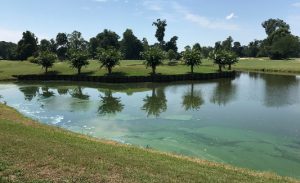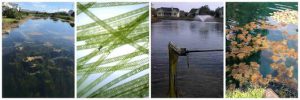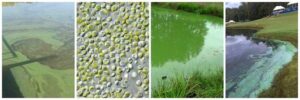Protecting Your Essential Water Resources From Algae and Toxic Cyanobacteria

When we face stress or challenges like coronavirus (COVID-19), our waterbodies provide us much needed space to find natural solitude, but, unfortunately, the health of these ecosystems can also become our last priority. It’s important to remember that your waterbody is an investment that needs to be protected. Ongoing management will help ensure that the progress you’ve made towards your lake and pond management goals is never reversed. One of the primary ways to ensure your waterbody stays healthy and safe for the community is through the proactive management of nuisance algae blooms.
Algae is present in all lakes and ponds, although we generally only become aware of it when it becomes a nuisance. At this stage, it can become aesthetically displeasing, create stagnant water conditions, deprive fish of oxygen, and produce bad odor. Some species also produce toxins that can dangerously impact drinking water and are linked to the death of pets and the development of human diseases. Luckily, lake and pond professionals have many approaches for the safe and eco-friendly management of algae blooms. The first step is to conduct water quality tests that identify the type of algae present. While more than 30,000 species of algae are known to exist, we most often encounter three categories: filamentous, planktonic, and macro-algae.
Filamentous Algae
Patches of filamentous algae are typically long, stringy and slimy. The filaments are made up of cells joined end to end which give the thread-like appearance. These patches are often bright green, but can exhibit browns or yellows – especially if the algae is dying. Small stormwater ponds and large lake shorelines can be overcome with filamentous algae due to stagnation or high nutrient load. Without proper management, filamentous algae can interfere with boating, fishing and swimming.

Planktonic Algae
Planktonic algae are microscopic organisms that range in color from light blue, green, golden, to red; they are made up of one cell or colonies of single cells. When blooming or visually dense, planktonic algae appears more like dye in the water and cannot be pulled out of the water like filamentous or macro-algae. Blooms of planktonic algae will often blow across the pond with the wind and concentrate in corners or shorelines of the pond. Exposure to the toxins produced by a form of planktonic algae called cyanobacteria (blue-green algae) can lead to skin irritation, fever, muscle and joint pain, stomach cramps, diarrhea, vomiting, mouth ulcers, and other allergic reactions. While research on cyanobacteria health risks is still ongoing, diseases such as Alzheimer’s, Parkinson’s, or cancer may be linked to exposure. Cyanobacteria is particularly lethal for dogs that are exposed by swimming or wading in water that contains algae.

Macro-algae
Macro-algae are a group of algae more common in marine than freshwater systems; seaweeds are a type of macro-algae. As a multicellular algae, they are often confused with aquatic plants and occupy a similar ecological niche. Macro-algae can even grow like plants with a root-like system; however, they do not have true roots. Some species of macro-algae, like Starry Stonewort, are considered invasive throughout the country.

Often, nuisance algae blooms are a symptom of a larger water quality issue, whether it relates to pH levels, dissolved oxygen, or other water chemistry parameters. Depending on your goals and the characteristics of the unique freshwater ecosystem, a number of management solutions can be exercised to help support healthy water quality.
Stabilizing the shoreline and establishing a beneficial vegetative buffer comprised of native grasses and rushes can help filter out pollutants that enter the waterbody through stormwater runoff. Buffers should be allowed to grow 3-5 feet around the shoreline and trimmed annually. Biological bacteria and products like Phoslock, Alum or Biochar can also be applied to help create more balanced conditions within the water column. If muck and sediment are contributing to this issue, hydro-raking can also be used to physically remove these materials from the bottom of the waterbody while helping to restore overall depth and volume.
Water quality can be further balanced by establishing a floating fountain or submersed pond aeration system, both of which can help increase movement and levels of beneficial dissolved oxygen. For more challenging algae problems, recurring nanobubble treatments can be utilized. Some nanobubble technologies are registered with the Environmental Protection Agency (EPA) to eliminate certain forms of algae, including cyanobacteria and the associated toxins.
Our lakes and ponds are spaces for relaxation, reflection and refuge from the sources of stress in our daily lives. Whether you spend time outdoors to unplug from the news, enjoy solitude, or build on your connection with nature, it’s important to keep your waterbody healthy and safe by exercising ongoing proactive management.









